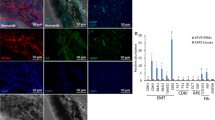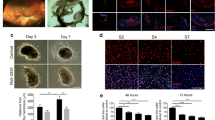Abstract
Proliferative vitreoretinopathy (PVR) is thought to represent an exaggerated and protracted scarring process following rhegmatogenous retinal detachment (RD) and following RD surgery. Following detachment, a combination of retinal ischaemia, inflammation and cell proliferation lead to the formation of tractional membranes on the epiretinal and subretinal surfaces and to marked gliosis within the retina that leads to retinal shortening. Both of these factors convert a rhegmatogenous RD into a tractional one are a major feature of RD surgery failure. The major cell types that are involved in PVR are retinal pigment epithelium (RPE), glial cells (principally Muller cells) and inflammatory cells (macrophages and lymphocytes). These cells interact with numerous growth factors and cytokines derived from the breakdown of the blood–retinal barrier and from vitreous contact that trigger a cascade of cellular processes, such as epithelial–mesenchymal transition (EMT), cell migration, chemotaxis, proliferation, elaboration of basement membrane and collagen and cellular contraction, that lead to overt retinal pathology. This review covers the histopathology of PVR and touches upon the cellular processes involved in the pathogenesis of PVR.
摘要
增殖性玻璃体视网膜病变 (PVR) 为孔源性视网膜脱离 (RD) 和RD手术后的过度而持久的瘢痕形成过程。视网膜脱离后, 由视网膜缺血、炎症和细胞增殖共同导致了视网膜表面和视网膜下形成了牵拉性增殖膜, 造成视网膜纤维增生并导致视网膜皱缩 。这些因素将孔源性RD转变为牵拉性RD, 是RD手术失败的主要特征。在PVR的病理形成中主要包括视网膜色素上皮 (RPE) 细胞、胶质细胞 (主要为Muller细胞) 和炎性细胞 (巨噬细胞和淋巴细胞) 。这些细胞与其它来源于血视网膜屏障破坏和玻璃体的大量生长因子和细胞因子相互作用, 触发细胞级联反应, 如上皮-间质转化 (EMT) 、细胞迁移、趋化、增殖, 基底膜与胶原的修饰以及细胞的收缩从而导致视网膜病变。本文综述了PVR的组织病理学以及各种细胞在PVR病理发病机制中的作用。
\u589e\u6b96\u6027\u89c6\u7f51\u819c\u75c5\u53d8\uff08\u0050\u0056\u0052\uff09\u7ec4\u7ec7\u75c5\u7406\u5b66\u7684\u7b80\u8981\u56de\u987e\u000d\u000a\u000d\u000a\u6458\u8981\u000d\u000a\u000d\u000a\u589e\u6b96\u6027\u73bb\u7483\u4f53\u89c6\u7f51\u819c\u75c5\u53d8\uff08\u0050\u0056\u0052\uff09\u4e3a\u5b54\u6e90\u6027\u89c6\u7f51\u819c\u8131\u79bb\uff08\u0052\u0044\uff09\u548c\u0052\u0044\u624b\u672f\u540e\u7684\u8fc7\u5ea6\u800c\u6301\u4e45\u7684\u7622\u75d5\u5f62\u6210\u8fc7\u7a0b\u3002\u89c6\u7f51\u819c\u8131\u79bb\u540e\uff0c\u7531\u89c6\u7f51\u819c\u7f3a\u8840\u3001\u708e\u75c7\u548c\u7ec6\u80de\u589e\u6b96\u5171\u540c\u5bfc\u81f4\u4e86\u89c6\u7f51\u819c\u8868\u9762\u548c\u89c6\u7f51\u819c\u4e0b\u5f62\u6210\u4e86\u7275\u62c9\u6027\u589e\u6b96\u819c\uff0c\u9020\u6210\u89c6\u7f51\u819c\u7ea4\u7ef4\u589e\u751f\u5e76\u5bfc\u81f4\u89c6\u7f51\u819c\u76b1\u7f29\u0020\u3002\u8fd9\u4e9b\u56e0\u7d20\u5c06\u5b54\u6e90\u6027\u0052\u0044\u8f6c\u53d8\u4e3a\u7275\u62c9\u6027\u0052\u0044\uff0c\u662f\u0052\u0044\u624b\u672f\u5931\u8d25\u7684\u4e3b\u8981\u7279\u5f81\u3002\u5728\u0050\u0056\u0052\u7684\u75c5\u7406\u5f62\u6210\u4e2d\u4e3b\u8981\u5305\u62ec\u89c6\u7f51\u819c\u8272\u7d20\u4e0a\u76ae\uff08\u0052\u0050\u0045\uff09\u7ec6\u80de\u3001\u80f6\u8d28\u7ec6\u80de\uff08\u4e3b\u8981\u4e3a\u004d\u0075\u006c\u006c\u0065\u0072\u7ec6\u80de\uff09\u548c\u708e\u6027\u7ec6\u80de\uff08\u5de8\u566c\u7ec6\u80de\u548c\u6dcb\u5df4\u7ec6\u80de\uff09\u3002\u8fd9\u4e9b\u7ec6\u80de\u4e0e\u5176\u5b83\u6765\u6e90\u4e8e\u8840\u89c6\u7f51\u819c\u5c4f\u969c\u7834\u574f\u548c\u73bb\u7483\u4f53\u7684\u5927\u91cf\u751f\u957f\u56e0\u5b50\u548c\u7ec6\u80de\u56e0\u5b50\u76f8\u4e92\u4f5c\u7528\uff0c\u0020\u89e6\u53d1\u7ec6\u80de\u7ea7\u8054\u53cd\u5e94\uff0c\u5982\u4e0a\u76ae\u002d\u95f4\u8d28\u8f6c\u5316\uff08\u0045\u004d\u0054\uff09\u3001\u7ec6\u80de\u8fc1\u79fb\u3001\u8d8b\u5316\u3001\u589e\u6b96\uff0c\u57fa\u5e95\u819c\u4e0e\u80f6\u539f\u7684\u4fee\u9970\u4ee5\u53ca\u7ec6\u80de\u7684\u6536\u7f29\u4ece\u800c\u5bfc\u81f4\u89c6\u7f51\u819c\u75c5\u53d8\u3002\u672c\u6587\u7efc\u8ff0\u4e86\u0050\u0056\u0052\u7684\u7ec4\u7ec7\u75c5\u7406\u5b66\u4ee5\u53ca\u5404\u79cd\u7ec6\u80de\u5728\u0050\u0056\u0052\u75c5\u7406\u53d1\u75c5\u673a\u5236\u4e2d\u7684\u4f5c\u7528\u3002\u000d\u000a
Similar content being viewed by others
Log in or create a free account to read this content
Gain free access to this article, as well as selected content from this journal and more on nature.com
or
References
The classification of retinal detachment with proliferative vitreoretinopathy. Ophthalmology. 1983;90:121–5. PMID: 6856248. https://doi.org/10.1016/s0161-6420(83)34588-7.
Lean JS, Stern WH, Irvine AR, Azen SP. Classification of proliferative vitreoretinopathy used in the silicone study. The Silicone Study Group. Ophthalmology. 1989;96:765–71.
Pastor JC, Fernandez I, Rodriguez de la Rua E, Coco R, Sanabria-Ruiz Colmenares MR, et al. Surgical outcomes for primary rhegmatogenous retinal detachments in phakic and pseudophakic patients: the retina 1 project report 2. Br J Ophthalmol. 2008;92:378–82.
Pennock S, Haddock LJ, Eliott D, Mukai S, Kazlauskas A. Is neutralizing vitreal growth factors a viable strategy to prevent proliferative vitreoretinopathy? Prog Retin Eye Res. 2014;40:16–34.
Kampik A, Kenyon KR, Michels RG, Green WR, de la Cruz ZC. Epiretinal and vitreous membranes. Comparative study of 56 cases. Arch Ophthalmol. 1981;99:1445–54.
Hiscott PS, Grierson I, Hitchins CA, Rahi AH, McLeod D. Epiretinal membranes in vitro. Trans Ophthalmol Soc U K. 1983;103:89–102.
Hiscott PS, Grierson I, McLeod D. Retinal pigment epithelial cells in epiretinal membranes: an immunohistochemical study. Br J Ophthalmol. 1984;68:708–15.
Jerdan JA, Pepose JS, Michels RG, Hayashi H, de Bustros S, Sebag M, et al. Proliferative vitreoretinopathy membranes. An immunohistochemical study. Ophthalmology. 1989;96:801–10.
Hiscott P, Hagan S, Heathcote L, Sheridan CM, Groenewald CP, Grierson I, et al. Pathobiology of epiretinal and subretinal membranes: possible roles for the matricellular proteins thrombospondin 1 and osteonectin (SPARC). Eye. 2002;16:393–403.
Trese MT, Chandler DB, Machemer R. Subretinal strands: ultrastructural features. Graefes Arch Clin Exp Ophthalmol. 1985;223:35–40.
Wilkes SR, Mansour AM, Green WR. Proliferative vitreoretinopathy. Histopathology of retroretinal membranes. Retina. 1987;7:94–101.
Sternberg P Jr, Machemer R. Subretinal proliferation. Am J Ophthalmol. 1984;98:456–62.
Garweg JG, Tappeiner C, Halberstadt M. Pathophysiology of proliferative vitreoretinopathy in retinal detachment. Surv Ophthalmol. 2013;58:321–9.
Pinon RM, Pastor JC, Saornil MA, Goldaracena MB, Layana AG, Gayoso MJ, et al. Intravitreal and subretinal proliferation induced by plateletrich plasma injection in rabbits. Curr Eye Res. 1992;11:1047–55.
Pastor JC, Rodriguez de la Rua E, Martin F, Mayo-Iscar A, de la Fuente MA, Coco R, et al. Retinal shortening: the most severe form of proliferative vitreoretinopathy (PVR). Arch la Soc Espanola Oftalmol. 2003;78:653–7.
Pastor JC, Mendez MC, de la Fuente MA, Coco RM, Garcia-Arumi J, Rodriguez de la Rua E, et al. Intraretinal immunohistochemistry findings in proliferative vitreoretinopathy with retinal shortening. Ophthalmic Res. 2006;38:193–200.
Machemer R, van Horn D, Aaberg TM. Pigment epithelial proliferation in human retinal detachment with massive periretinal proliferation. Am J Ophthalmol. 1978;85:181–91.
Chiba C. The retinal pigment epithelium: an important player of retinal disorders and regeneration. Exp Eye Res. 2014;123:107–14.
Chen HJ, Ma ZZ. N-cadherin expression in a rat model of retinal detachment and reattachment. Investig Ophthalmol Vis Sci. 2007;48:1832–8.
Wickham L, Charteris DG. Glial cell changes of the human retina in proliferative vitreoretinopathy. Dev Ophthalmol. 2009;44:37–45.
Fischer AJ, Zelinka C, Milani-Nejad N. Reactive retinal microglia, neuronal survival, and the formation of retinal folds and detachments. Glia. 2015;63:313–27.
Eastlake K, Banerjee PJ, Angbohang A, Charteris DG, Khaw PT, Limb GA. Müller glia as an important source of cytokines and inflammatory factors present in the gliotic retina during proliferative vitreoretinopathy. Glia. 2016;64:495–506.
Dongre A, Weinberg RA. New insights into the mechanisms of epithelial-mesenchymal transition and implications for cancer. Nat Rev Mol Cell Biol. 2019;20:69–84.
Li H, Wang H, Wang F, Gu Q, Xu X. Snail involves in the transforming growth factor beta1-mediated epithelial-mesenchymal transition of retinal pigment epithelial cells. PLoS ONE. 2011;6:e23322.
Kimoto K, Nakatsuka K, Matsuo N, Yoshioka H. p38 MAPK mediates the expression of type I collagen induced by TGF-beta 2 in human retinal pigment epithelial cells ARPE-19. Investig Ophthalmol Vis Sci. 2004;45:2431–7.
Yokoyama K, Kimoto K, Itoh Y, Nakatsuka K, Matsuo N, Yoshioka H, et al. The PI3K/Akt pathway mediates the expression of type I collagen induced by TGF-beta2 in human retinal pigment epithelial cells. Graefes Arch Clin Exp Ophthalmol. 2012;250:15–23.
Kita T, Hata Y, Arita R, Kawahara S, Miura M, Nakao S, et al. Role of TGF-beta in proliferative vitreoretinal diseases and ROCK as a therapeutic target. Proc Natl Acad Sci USA. 2008;105:17504–9.
Chen X, Xiao W, Liu X, Zeng M, Luo L, Wu M, et al. Blockade of Jagged/Notch pathway abrogates transforming growth factor beta2-induced epithelial-mesenchymal transition in human retinal pigment epithelium cells. Curr Mol Med. 2014;14:523–34.
Cheng HC, Ho TC, Chen SL, Lai HY, Hong KF, Tsao YP. Troglitazone suppresses transforming growth factor beta-mediated fibrogenesis in retinal pigment epithelial cells. Mol Vis. 2008;14:95–104.
Chen X, Xiao W, Wang W, Luo L, Ye S, Liu Y. The complex interplay between ERK1/2, TGFbeta/Smad, and Jagged/Notch signaling pathways in the regulation of epithelial-mesenchymal transition in retinal pigment epithelium cells. PLoS ONE. 2014;9:e96365.
Cui J, Lei H, Samad A, Basavanthappa S, Maberley D, Matsubara J, et al. PDGF receptors are activated in human epiretinal membranes. Exp Eye Res. 2009;88:438–44.
Pennock S, Rheaume MA, Mukai S, Kazlauskas A. A novel strategy to develop therapeutic approaches to prevent proliferative vitreoretinopathy. Am J Pathol. 2011;179:2931–40.
Lei H, Velez G, Hovland P, Hirose T, Gilbertson D. Kazlauskas growth factors outside the PDGF family drive experimental PVR. Investig Ophthalmol Vis Sci. 2009;50:3394–403.
Lei H, Kazlauskas AJ. Growth factors outside of the platelet-derived growth factor (PDGF) family employ reactive oxygen species/Src family kinases to activate PDGF receptor alpha and thereby promote proliferation and survival of cells. Biol Chem. 2009;284:6329–36.
Lei H, Rheaume MA, Velez G, Mukai S, Mazlauskas A. Expression of PDGFRalpha is a determinant of the PVR potential of ARPE19 cells. Investig Ophthalmol Vis Sci. 2011;52:5016–21.
Rojas J, Fernandez I, Pastor JC, Garcia-Gutierrez MT, Sanabria MR, Brion M, et al. A strong genetic association between the tumor necrosis factor locus and proliferative vitreoretinopathy: the retina 4 project. Ophthalmology. 2010;117:2417.
Kon CH, Occleston NL, Aylward GW, Khaw PT. Expression of vitreous cytokines in proliferative vitreoretinopathy:a prospective study. Investig Ophthalmol Vis Sci. 1999;40:705–12.
Lashkari K, Rahimi N, Kazlauskas A. Hepatocyte growth factor receptor in human RPE cells: implications in proliferative vitreoretinopathy. Investig Ophthalmol Vis Sci. 1999;40:149–56.
Kenarova B, Voinov L, Apostolov C, Vladimirova R, Misheva A. Levels of some cytokines in subretinal fluid in proliferative vitreoretinopathy and rhegmatogenous retinal detachment. Eur J Ophthalmol. 1997;7:64–67.
Author information
Authors and Affiliations
Corresponding author
Ethics declarations
Conflict of interest
The author declares that they have no conflict of interest.
Additional information
Publisher’s note Springer Nature remains neutral with regard to jurisdictional claims in published maps and institutional affiliations.
Rights and permissions
About this article
Cite this article
Mudhar, H.S. A brief review of the histopathology of proliferative vitreoretinopathy (PVR). Eye 34, 246–250 (2020). https://doi.org/10.1038/s41433-019-0724-4
Received:
Accepted:
Published:
Issue date:
DOI: https://doi.org/10.1038/s41433-019-0724-4
This article is cited by
-
Absent in melanoma 2: a potent suppressor of retinal pigment epithelial-mesenchymal transition and experimental proliferative vitreoretinopathy
Cell Death & Disease (2025)
-
Non-surgical interventions for proliferative vitreoretinopathy—a systematic review
Eye (2025)
-
Changes of aqueous humor cytokine profiles of patients with high intraocular pressure after PPV for retinal detachment
Scientific Reports (2024)
-
Hyalocytes—guardians of the vitreoretinal interface
Graefe's Archive for Clinical and Experimental Ophthalmology (2024)
-
Epithelial-mesenchymal Transition (EMT) and the Effect of Atorvastatin on it in ARPE-19 cells
Cell Biochemistry and Biophysics (2024)



